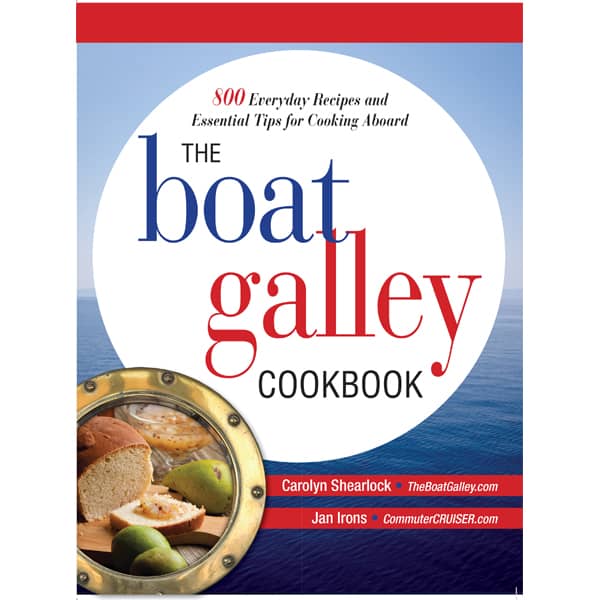One of the great parts of cruising is the fresh seafood you get. Whether it’s from the back deck, a local fisherman, or even a fish market, it’s SO good when it’s fresh. But sometimes there’s more than you need for one meal. How do you store it?
I’ll admit that I feel sort of funny writing this article. If you already fish a lot or live on the coast where seafood is abundant, you’re going to laugh that anyone needs to be told this. But Dave and I are from the midwest, and we didn’t know a thing about seafood when we began cruising. Luckily, other cruisers and some local fishermen took pity on us and taught Dave how to fillet a fish and me how to freeze the fillets and cook them. So if you don’t have a background that includes a lot of seafood, read on . . .
Any seafood MUST be cleaned before it goes in the refrigerator or freezer. And unless it’s something you’re keeping alive (such as clams or fish in a live well), the sooner you clean it after catching it, the better it will be.
Unless you’re going to eat the seafood that same day, it’s best to freeze it unless your refrigerator can hold a temperature of 40 degrees or less. If you refrigerate it, be sure to put it in the coldest area of your refrigerator — low and near the chill plates. Even if your refrigerator will hold a temperature below 40 degrees, the FDA recommends freezing any seafood you’re not going to eat in 2 days.
To freeze seafood once it’s been cleaned, use towels or paper towels and pat it dry. The drier you get it, the better — the less ice that forms, the better the texture will be when it’s thawed again.
Then vacuum seal it or put it in a Ziploc freezer bag and get as much air out of the bag as possible. I like to put just enough for one meal for the two of us in a bag. Be sure to label the bag with a permanent marker with what it is, date frozen, and number of portions.
Things that have sharp spines — like lobster tails with the shells on — need to be double bagged in either the vacuum bags or Ziplocs to try to protect the contents against holes in the bag and freezer burn.
The faster the seafood freezes, the better it will be. Instead of just putting it on top of other things in your freezer, it’s good to take out some of the already-frozen food, put the new items in the middle, and then put the frozen items back on top.
When you’re ready to use the seafood, let it thaw in the bag. Immediately before cooking it, take it out of the bag and pat it dry again.
Buen provecho!

Carolyn Shearlock has lived aboard full-time for 17 years, splitting her time between a Tayana 37 monohull and a Gemini 105 catamaran. She’s cruised over 14,000 miles, from Pacific Mexico and Central America to Florida and the Bahamas, gaining firsthand experience with the joys and challenges of life on the water.
Through The Boat Galley, Carolyn has helped thousands of people explore, prepare for, and enjoy life afloat. She shares her expertise as an instructor at Cruisers University, in leading boating publications, and through her bestselling book, The Boat Galley Cookbook. She is passionate about helping others embark on their liveaboard journey—making life on the water simpler, safer, and more enjoyable.
Simplify meal prep on board with proven strategies for provisioning, maximizing fridge space, and cooking delicious meals aboard your boat.










dawn says
If I freeze anything with spikes, ie Dungeoness crab legs, I first try to cut or sand down the spikes so they don’t cause holes in the plastic. It’s also much more pleasant to eat them without being stabbed while tearing into the shells later on.
Sheila C. says
I don’t have a vacumn sealer. I insert a straw into the ziplock bag, zip it up tight to the straw and suck out all the air. Then while pulling the straw out, finish zipping the bag shut. Works great!
Don Anderson says
GREAT TIP!
I’m thinking that a longer piece if flexible tubing could get your face away from work and make it easier to see what your hands are doing..
I sold off my power sealer years ago. Found a manual Ziplock vacuum pump in a thrift store. Never have seen them new.
Downeast32 says
google for a pdf of this book: “Sailing the Farm”.
Christopher Phillips says
https://www.pdfdrive.com/sailing-the-farm-d186981999.html
MaryJo on Facebook says
Amen to that! Happy Thanksgiving, Carolyn.
Maryalice Mackey says
After freezing, when would you recommend eating the fish by?
Sam Steele says
We will wrap our fish in plastic wrap prior to putting it into a ziplock and squeezing it down to protect it from freezer burn.
Music says
My Mom came up with a great solution for the spines on Alaskan King Crab legs. She wraps them in a dish towel and then vacuum seals them.
Fred says
Great advise, but one question. When we lived in LA we were tauht to freeze our shrimp ( heads off) in water, in essence glazing them. I have tried to use the vacuumed sealer to no avail so we just put them in zip- lock bags and get as much air out as possible. It seems to work out ok but would be interested in other methods. Has anyone tried vacume bagging their shrimp?
Paul French says
I know your a cruiser, but its a Mahi or a Dolphin. I’m a bubblehead, we didn’t get our “Dorado”s. other than that, love the site.
Carolyn Shearlock says
In Mexico and Central America — where we cruised — Mahi is called Dorado.
Joysealife.com says
Put a little salt water in with it and then squeeze the air out of it. Zip your bag up until the last inch then put it down on a towel and squeeze until the water is coming out. Then quickly zip the last inch – – no air.
Elena Manighetti says
Hey do you have any tips for storing food without refrigeration? We won’t have a fridge on our little sailboat but we’ll live on it full-time 🙂